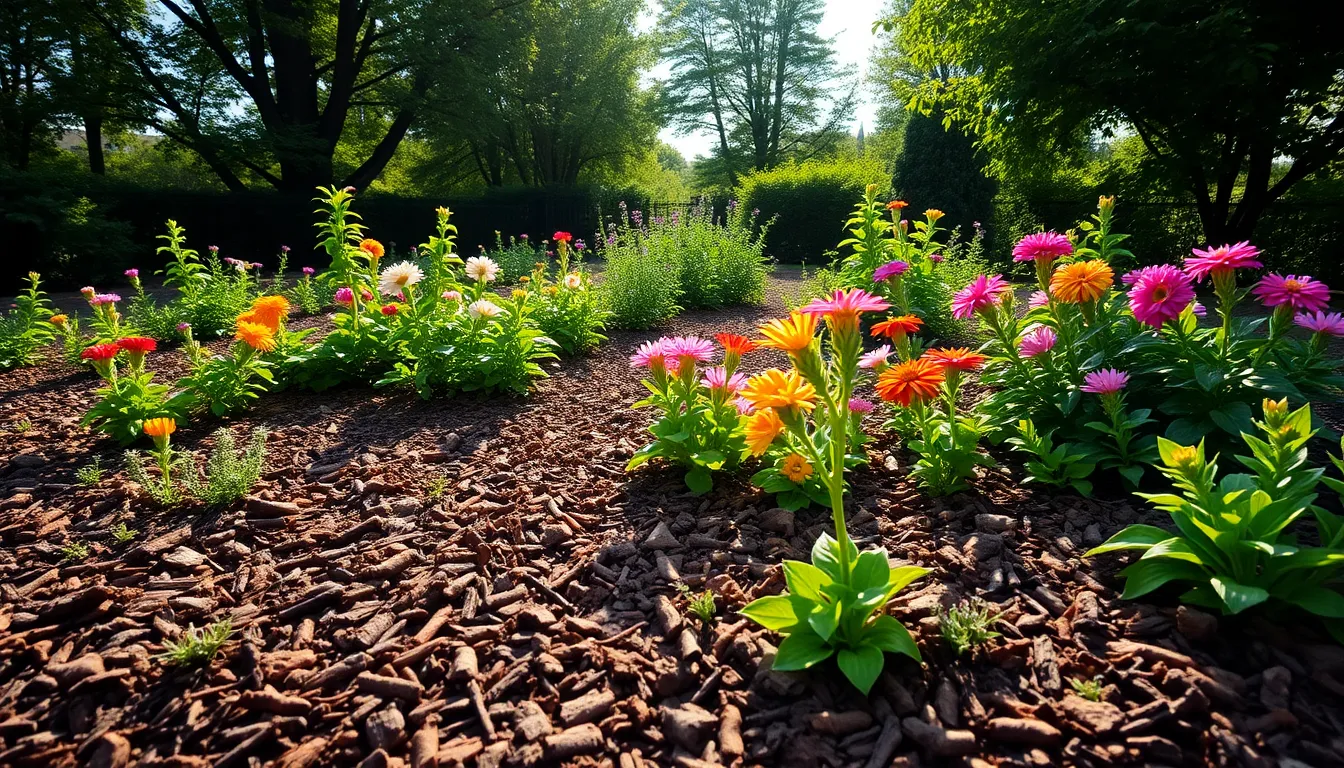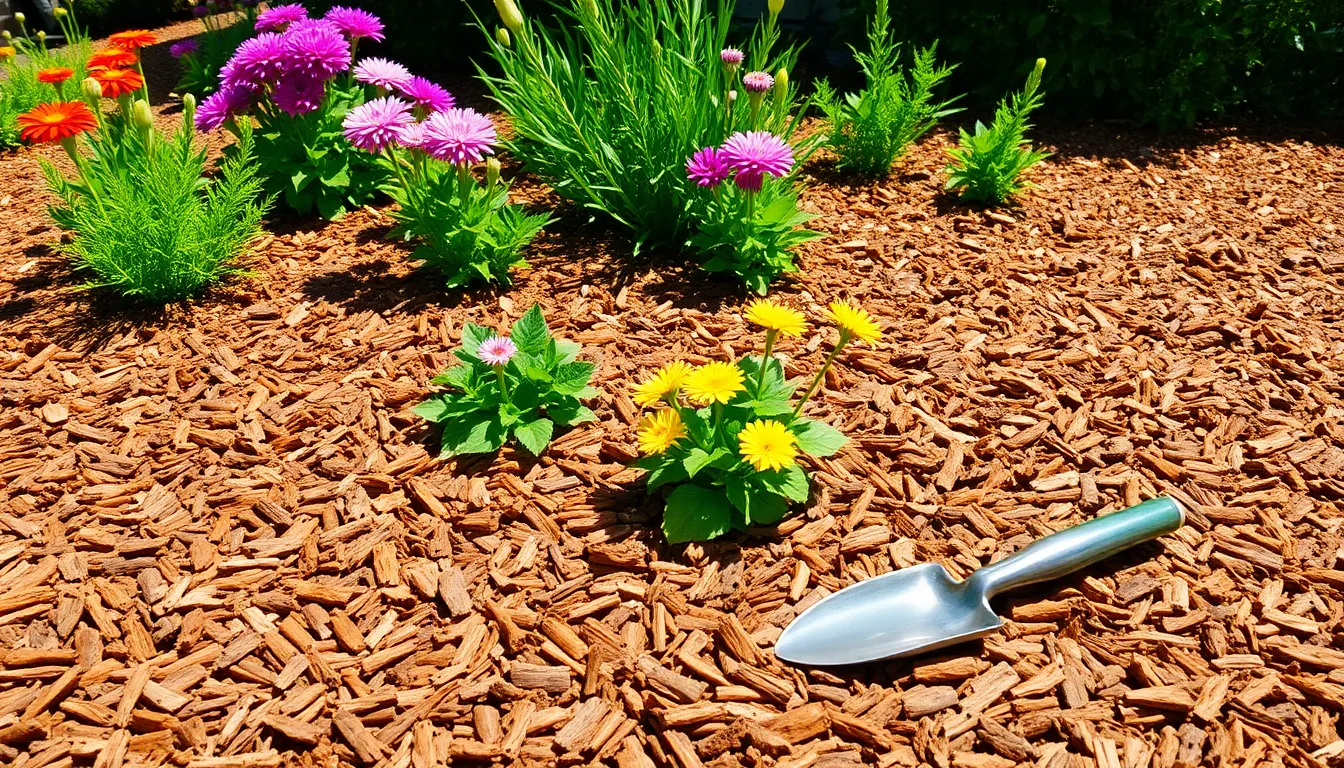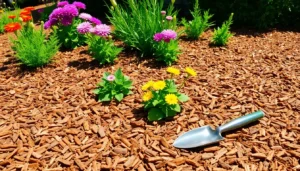Imagine a garden that looks like it just stepped off a magazine cover. Mulch landscaping can turn that dream into reality. Not only does it add a polished finish to any outdoor space, but it also brings a host of benefits that’ll make your plants happier than a kid in a candy store.
Table of Contents
ToggleWhat Is Mulch Landscaping?
Mulch landscaping refers to the practice of using organic or inorganic materials to enhance garden aesthetics and support plant health. This technique involves spreading mulch around plants, shrubs, and trees to improve soil moisture retention. Enhanced moisture levels lead to reduced watering needs, facilitating growth during dry spells.
Various types of mulch exist, including wood chips, bark, straw, and stones. Each option offers distinct benefits, such as weed suppression and soil temperature regulation. Applying mulch effectively reduces weed growth by blocking sunlight, which helps promote a healthier growing environment for desirable plants.
Plant health improves with proper mulch application. Organic mulch, when decomposed, enriches the soil with nutrients, benefiting root systems. Inorganic mulch, like rubber or gravel, offers long-lasting aesthetics without contributing to soil health. Selecting the right type of mulch can create a visually appealing landscape while also serving practical purposes.
A layer of 2 to 4 inches is ideal for optimal effectiveness. Spacing mulch away from plant stems prevents moisture buildup and potential rot. Regular maintenance, such as replenishing organic mulch each season, ensures ongoing benefits.
Mulch landscaping combines beauty and functionality. The use of mulch not only elevates garden designs but also directly supports plant vitality and resilience.
Benefits of Mulch Landscaping

Mulch landscaping offers several advantages that enhance garden aesthetics and support plant health.
Moisture Retention
Mulch effectively retains soil moisture, benefiting plants during dry spells. Covering the soil reduces evaporation, allowing roots to access essential moisture. Organic mulch contributes further by breaking down and enriching the soil, promoting a healthier environment. A layer of 2 to 4 inches is recommended for optimal moisture retention. Incorporating mulch around plants ensures they maintain adequate hydration levels, reducing the frequency of watering.
Weed Control
Weed control becomes more manageable with mulch landscaping. Applying a thick layer inhibits sunlight, preventing weed germination and growth. Consequently, this saves time and effort associated with weeding tasks. Organic mulches gradually decompose, providing additional nutrients while still suppressing weeds. Regularly maintaining the mulch helps to maintain its effectiveness against stubborn weed populations.
Soil Health Improvement
Soil health experiences significant improvement through mulch application. Organic mulch decomposes over time, enriching the soil with beneficial nutrients. Healthy soil fosters robust plant growth and vibrant blooms. Mulch also aids in temperature regulation, keeping soil cooler during hot weather and warmer during colder months. Enhanced biodiversity in the soil supports beneficial microorganisms, contributing to overall garden health and resilience.
Types of Mulch
Mulch comes in two main categories: organic and inorganic. Both types serve unique roles in landscaping and provide distinct benefits.
Organic Mulch
Organic mulch consists of natural materials that decompose over time. Options include wood chips, shredded bark, straw, and leaves. As these materials break down, they enrich the soil with nutrients, enhancing plant health. This type of mulch helps retain moisture by reducing evaporation, which is particularly important in dry conditions. Organic mulch also fosters a healthy ecosystem, promoting beneficial microorganisms that thrive in enriched soil. A recommended thickness of 2 to 4 inches ensures optimal moisture retention, while positioning the mulch away from plant stems prevents moisture buildup and plant rot.
Inorganic Mulch
Inorganic mulch includes materials like gravel, stones, and plastic sheeting. These options do not decompose and provide a long-lasting aesthetic appeal to landscaping. Gravel and stones effectively regulate soil temperature while also suppressing weeds, making them ideal for low-maintenance gardens. Plastic mulch can prevent moisture loss and improve soil warmth, which is advantageous for certain crops. When using inorganic materials, consider the specific needs of the plants and overall garden design. A consistent layer of 2 to 3 inches often delivers the desired benefits, creating a visually appealing and functional landscape.
How to Use Mulch in Landscaping
Mulch enhances landscaping by offering visual appeal and significant plant benefits. Proper application ensures maximum effectiveness.
Mulch Application Techniques
Applying mulch requires careful techniques for optimal results. Begin by clearing the area of weeds and debris. Next, spread mulch evenly around plants, avoiding direct contact with stems. This prevents moisture buildup, reducing the risk of disease. Consider layer thickness when applying to ensure even distribution. Consistent coverage creates a uniform look while enhancing functionality. Finally, refresh existing mulch annually to maintain its benefits.
Recommended Depth and Coverage
Depth and coverage are vital for effective mulch use. Aim for a thickness of 2 to 4 inches for organic types to promote moisture retention. Inorganic options benefit from a 2 to 3 inch layer for effective weed suppression. Coverage should extend to the drip line of plants, providing comprehensive protection. Maintaining these depths prevents soil erosion and keeps plant roots insulated. Regular assessment of mulch levels helps maintain these standards throughout the growing season.
Common Mistakes to Avoid
Mulch landscaping can enhance beauty and health but certain mistakes can undermine its effectiveness. One common error involves applying too much mulch. Excessive layering can suffocate plant roots, leading to poor growth.
Failing to choose the right mulch type constitutes another mistake. Organic mulch works well for moisture retention and soil enrichment, while inorganic mulch provides durability and aesthetics. Maintaining the proper depth, typically 2 to 4 inches for organic options and 2 to 3 inches for inorganic types, ensures optimal performance.
Ignoring proper clearance before application can also pose challenges. It’s crucial to remove weeds and debris to prevent competition for nutrients and water. Mulching directly against plant stems often leads to moisture problems and disease.
Overlooking seasonal maintenance is another oversight. Regular assessments and annual refreshes keep mulch effective throughout the growing season.
Neglecting to extend mulch to the drip line can limit its benefits. Full coverage around the plant protects roots and enhances moisture retention.
Lastly, selecting low-quality mulch can diminish results. Quality matters as it impacts decomposition rates and nutrient enrichment in the soil. Avoiding these common mistakes can significantly improve the success of mulch landscaping, ensuring a thriving garden.
Mulch landscaping is a powerful tool for any gardener looking to enhance their outdoor space. By choosing the right type of mulch and applying it correctly, individuals can create a thriving environment for their plants while also adding visual appeal. The benefits of mulch extend beyond aesthetics; it plays a critical role in moisture retention and soil health.
Regular maintenance and proper application techniques ensure that gardens remain vibrant and healthy. Avoiding common pitfalls like over-mulching and neglecting seasonal upkeep can make a significant difference in the longevity and effectiveness of mulch. Embracing mulch landscaping not only beautifies gardens but also supports sustainable practices that contribute to plant vitality and resilience.







